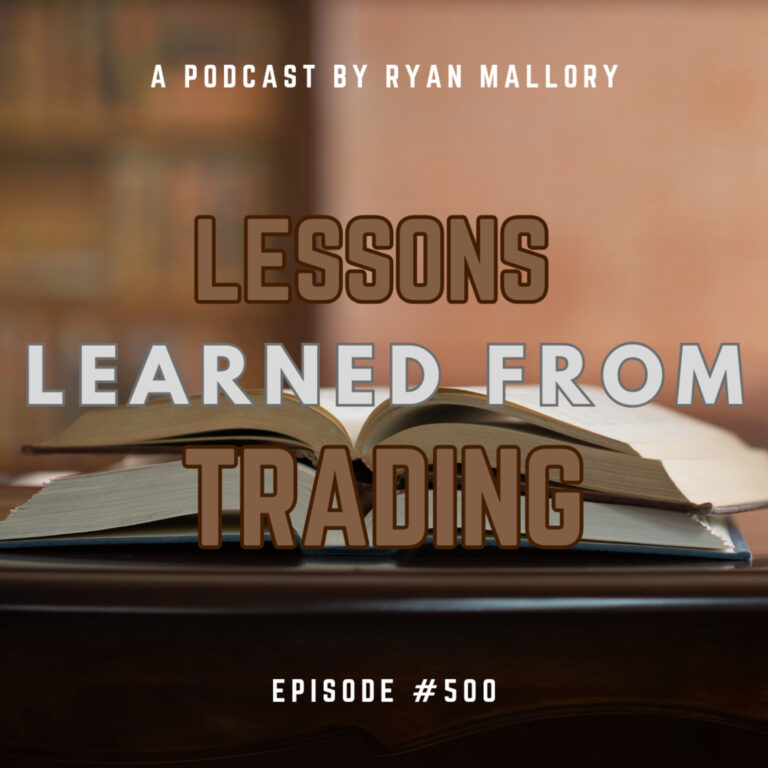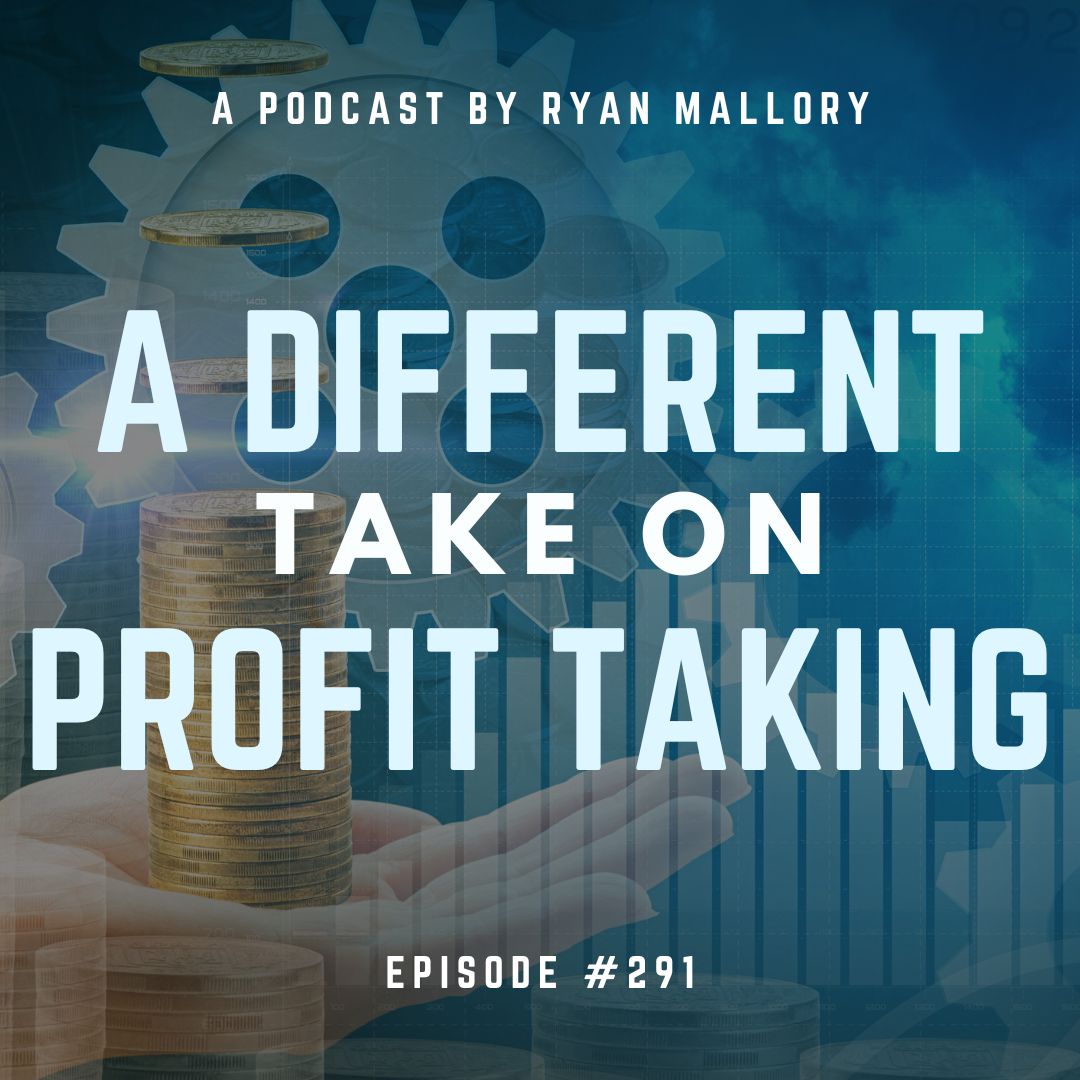Episode Overview
A listener of the podcast offers up a really cool and unique approach to profit taking that I really like, and will even consider implementing into my own swing-trading strategy & approach to profit taking.
Available on: Apple Podcasts | Spotify | Amazon | YouTube
Episode Highlights & Timestamps
- [0:07] Introduction
Ryan opens the episode with a listener email that introduces a unique way to manage stop losses. - [1:22] Mo’s Layered Stop Strategy
Mo explains how he divides his trades into smaller segments, placing different stop-loss levels to manage risk and lock in partial profits. - [5:17] Real-World Trade Reflection
Ryan revisits a recent QLD trade and considers how Mo’s technique could have improved his overall results. - [7:40] Evolving Profit-Taking Techniques
Ryan reflects on how commission-free trading allows for more creative strategies like Mo’s, including staggered exits. - [10:21] Adapting to Market Volatility
Ryan emphasizes how Mo’s stop-loss method helps preserve gains and reduce risk in unpredictable markets.
Key Takeaways from This Episode:
- Layered Stop-Losses Can Capture More Profit: By setting different stop-losses for different portions of a trade, you can extract gains from smaller moves without exiting the entire position.
- Volatility Demands Flexibility: Mo’s strategy shines in choppy markets where a trade might move slightly in your favor before reversing.
- Trade Reviews Can Improve Future Outcomes: Reflecting on recent trades, like Ryan’s QLD example, helps identify ways to optimize entries and exits.
- Commission-Free Trading Enables Creativity: With no commission fees, breaking trades into multiple segments is more feasible and worth exploring.
- Be Open to New Ideas: Even experienced traders can benefit from community insights and be reminded to stay adaptive in their strategies.
Resources & Links Mentioned:
- Swing Trading the Stock Market – Daily market analysis, trade setups, and insights by Ryan Mallory.
- Join the SharePlanner Trading Block – Get real-time trade alerts and community support.

Take the Next Step:
✅ Stay Connected: Subscribe to Ryan’s newsletter to get free access to Ryan’s Swing Trading Resource Library, along with receiving actionable swing trading strategies and risk management tips delivered straight to your inbox.
📈 Level Up Your Trading: Ready for structured training? Enroll in Ryan’s Swing Trading Mastery Course, The Self-Made Trader, and get the complete trading course, from the foundational elements of trading to advanced setups and profitable strategies.
📲 Join the Trading Community: Sign up for SharePlanner’s Trading Block to become part of Ryan’s swing-trading community, which includes all of Ryan’s real-time swing trades and live market analysis.
Full Episode Transcript
Click here to read the full transcript
0:07
Hey, I’m Ryan Mallory and this is my swing trading the stock market podcast. I’m here to teach you how to trade in a complex ever-changing, world of Finance, learn what it means to trade, profitably and consistently managing risk, avoiding the pitfalls of trading. And most importantly, to let those winners run wild, you can succeed at the stock market, and I’m ready to show you how, hey, everybody, this is Ryan.
0:31
Mallory with Swing Trading the Stock Market in today’s episode, I think it’s gonna You’re pretty good one here. I got good bourbon, I got a good email, really good. Email, we’re going to call this guy mow. And for those wondering, why do I call this guy mow? It’s because I give everybody a Florida. Redneck name, being that I am from Florida.
0:47
I live in Florida and I don’t want to use their real name, so I give them a redneck name. So Mo here has a really cool way of taking profits and I’m kind of for it, he writes, hey, Ryan, I like your thoughts on a recent trading strategy. I’ve been trying with the current market volatility.
1:02
Most of it builds on many of the principles that you have laid out. Out on the podcast, I get into a position based on the reward to risk principles. And also use technical analysis that identify key support levels for setting the stop losses so far like everything that he’s writing. What I’ve been doing a little differently is once a position becomes profitable but not yet.
1:22
At my 221 reward level is breaking up a position into two or more positions with different stop losses in a volatile Market. This is netted me some profits that otherwise wouldn’t have stayed in a portfolio. But it also allows Room to pull back without completely taking me out of a position.
1:40
As an example, say, I bought 90 shares of stock XYZ identified, the key support level to set my initial stop loss, below say around 96 percent of the purchase price. So I would seek to make at least eight percent profit before taking off the first one third of a position. After several days XYZ has gone up three point five percent from the purchase price.
1:59
Here, I identify a higher support level, maybe a moving average or a short-term consolidation. Where I set a stop loss for 30 shares of XYZ. Let’s say, at 102 percent of the purchase price. The remaining 60 shares of XYZ, stay at the stop loss below, a stronger level of support that if broken, I definitely don’t want to be in that trade any longer.
2:20
This stop loss strategy, seems to capture some profits that I might not otherwise have had had I been waiting for that to 21. Reward risk threshold to hit if the market makes a rapid downturn. Like it often does recently, any thoughts that you?
2:35
Have on the strategy or how, to improve it, or welcome in. Should you try Jefferson’s? H2c bourbon. I had it recently and thought it was amazing. Thank you for everything you do with the podcast. Well, I’ve already had Jefferson at Sea. He even wrote me back to let me know that he realized that already had done Jefferson aged at Sea and it was a pretty good bourbon.
2:56
I think it’s really hyped up quite a bit, but it was a solid seven point four so you can argue with that one. But this is a really cool email because this email here, maybe think a little bit on my own trading strategy like where have I done trading in the past and maybe even recently where I could have employed that strategy may be extracted, a few more bucks out of my trade.
3:14
But before I get into that let’s talk about what I am drinking for this podcast. This one comes from my brother. He came down to visit me not too long ago and I’m going to Buddy brought me some bourbon two bottles. In fact, this one here is called bridge and Main American wheat, bourbon whiskey, finished with toasted White Oak.
3:31
It’s got 90 Proof, 45% alcohol, This is what the manufacturer says and remember guys I don’t get paid to talk about the bourbon. So this is a completely unbiased review us as, with all due respect to tradition stories of Heritage, and long forgotten recipes.
3:47
It’s really all about the taste. Bridget, main starts with a mash bill that uses less corn. Just enough to call it bourbon a good bit more wheat than some and only a fraction of the barley. This makes it smoother more flavorful and slightly less sweet designed for you, not for your grandfather.
4:05
All right, so they’re definitely taken a stab at some of your like, says rack distilleries, your old Forester Buffalo Trace because they’re young, right? So they’re trying to establish their own little niche in the market, the II mean, it looks beautiful. I mean it’s a really nice light brown color, you definitely pick up smells of Oak, not to The Taste, it’s got some floral flavors.
4:26
I’m not huge on the floor and it took me a little bit to pick up with that flavor was. But it’s definitely floral and then it’s followed up with some nutty flavors. I don’t like floral and we’ll it their basic offering. I think it’s awful. This one wasn’t as bad though.
4:42
So this one was tolerable. The nuttiness came in at right afterwards so it kind of wipe that out to the Finish. There’s a little bit of an ethanol little bit of a burn, but nothing to really freak out about. Could this be a everyday sipper? Yeah, it’s like $27. I think at $27 it’s an everyday sipper, not necessarily something.
4:59
I would focus on during the weekends but during the week. Absolutely, 7.1 is what I’m going to give this one. One, that’s bridge and Main American whiskey. Now, back to Moe’s email. This guy really made me think a little bit here, and I was thinking, even maybe with a recent trade that like, for instance, in qld.
5:17
So in my recent trading qld, I got in back on the 28th, I got in at like, 3859 had a stop loss at 37:48. I sold my first fourth of a position at 39 81 for 3.2 percent profit. Same day, I got into it. I was feeling really, really good about this last Friday.
5:35
Monday comes around, I closed a third, Al for a 1.3 percent profit, which was about like a quarter of my original position. So now I’m down to a half osition today. Then the market is really flounders, it just doesn’t do much. And I’m thinking to myself, okay, I ended up selling the remaining portion of that trade for like a point eight or nine percent loss the last half.
5:56
But overall in the trade, I was still profitable as profitable by like point seven percent. So then and that’s not a ton right? But in the end I did make three point two percent on a core. Another one point three percent on another quarter was just the final half that I didn’t really make anything on but I have to ask myself. What I have been better served and I’ve never really thought about this with my trading. So this is why this email really has me. Curious, is there a way? And I really need to think about it too. And you know, in the future going forward, if I play Separate, stop losses. So on the last half of the position that I had, could I have taken half of that last half, and had a stoploss a little bit higher. And then stuck to my original stop loss or even maybe even raise that one up. It just Not as much. And then basically said, okay, if it doesn’t win a rally, I’ll get knocked out here and they’re not, we’re like another 1% gain and then I’ll get finally knocked out at the last quarter position for like a one percent loss.
6:47
I don’t think that would be a bad thing, I really don’t. So, one of the cool things about this podcast is I hear a lot of good ideas from you guys. And I really think that this is a solid approach to trade in that, you can do that, especially when he’s tightening, the stop loss is like, when you think about the way that I do profit-taking usually it’s an aggressive manner.
7:05
So I get in, let’s say, in stock XYZ at 100 and it goes up to 110 and I’m saying, okay, let’s take a third off and then it goes up to 115. I got right. Let’s take another third off and then it goes up to 120. Pulls back to 117 and I’m out of the final third.
7:23
All right. Good trait. You know, move on, let’s go to the next tree. That’s more of an aggressive form of profit-taking for the most part. The final third. It pulls back a little bit. I decide to go ahead and get out of the tray, but what this guy does. He’s saying, okay I want to start looking for a potential way to get out.
7:40
Make sure that I don’t put all my gains at risk by taking a portion of the position and raising the stop-loss up on it. Now he leaves the rest of the position at its original Mount but maybe he takes that first third and raises it up some saying. Okay, if it wants to keep going higher, that’s great. But I’m going to have the stop-loss here just in case it doesn’t.
7:55
So I don’t get stopped out. I think what mode came up with us, a really good idea. It’s funny because I’ve been doing this for a long time, and there was times where I never did the partial profits, mainly during a Time where there was a lot higher commissions but now that we live in a commission free environment, that’s really not the worst approach and it could be in a lot of ways better.
8:15
And I think for the qld trade that I closed out today that I got in on Friday, I could have probably come out maybe with like, instead of a point seven percent profit on that trade which isn’t anything great. I could have come away with maybe a one-and-a-half percent, maybe I could have doubled my profit on that trade.
8:32
So that’s definitely something worth considering in the future and something that I may even start to implement in my trades to be honest. I never really thought about partial profit-taking in that way. And I think it’s actually a pretty good idea when I do these podcasts. I don’t hold myself out there to be this Master Trader.
8:48
That doesn’t have flaws or doesn’t make mistakes or doesn’t have losing trades. When somebody comes up with a good idea, I’ll tell you this is one of the better ideas that I’ve seen on this show. And so I really first of all, you explained it really well too and because he threw a lot of numbers out, he probably explained it better in his email, than my response to it on this podcast because it’s hard to start talking about numbers when you’re not able to show a chart when it comes to swing trading.
9:11
So I try to do my best to where you don’t need a chart or make your brain fry because I’m throwing too many numbers out there but I do like his approach. I think it’s a different form of profit-taking that instead of okay it hits a certain level, I’m going to get out instead. It’s like saying, okay, we’re up like three or four percent.
9:26
I’d like to be able to get a little bit more out of it, but if it doesn’t, I’m okay taking some profits off the table at three percent, or whatever it might be. And if it keeps coming down, then you get stopped out at the rest. It’s not a bad approach at all. You want to know what else isn’t bad? swingtradingthestockmarket.com.
9:41
Yes, I’m going to plug this into this podcast because it does support the podcast. swingtradingthestockmarket.com is this podcast’s Patreon website that provides you with all of my stock market research each and every day. That’s going to be my weekly watch list, the list, the daily setups that I’m following each day plus you’re going to get stock market updates throughout the week in video format and big tech updates in video format and not.
10:05
To be outdone, you’re going to be getting breakdowns of different trade ideas that I come up with. And I’m going to be sending out various trade ideas and different things that you can take advantage of all by going to swingtradingthestockmarket.com. So check that out. And to Moe’s credit, he also talked about in a volatile market.
10:21
This has helped him out to net some profits. And I really think that this is probably a really good approach for volatile markets because when you get some of those momentary blips, you know, where the market might run up about 4–5 percent, you may not want to raise your stop loss all the way up to where you’re saying.
10:37
Okay. I’m up 5% on this trade and I’m going to raise my stop loss up to, you know, 104 percent of my original position. You may not want to do that with your whole position, but you might want to do that with a third of a position. If there’s a key technical level there that you want to identify, and you can put a stop loss just below with a third of your position.
10:55
It’s kind of like blackjack. Blackjack you get a good hand, there’s that times where you’ll want to like split it up into two separate hands. It’s essentially the same thing here, and in a market where there’s a huge lack of conviction to the upside and that even when you do get a couple days to the upside, it’s very easy for it to give it all back the following day off of a news piece.
11:15
This is really not a bad idea to be able to protect some of those gains. So I really loved getting this email from Moe. I think he offered up a really cool approach to trading and something that I’ll probably do even in my own trading and it’s really kind of a different way of doing it. Like, oftentimes we’ll say, okay, I’ll take profits at this level if it gets up to there but essentially what Moe’s doing is like, okay, we’re pretty close.
11:35
But if it comes back down to this level, I’ll get out. Not bad at all. Having two separate stop losses. You can do that. Good stuff, Moe. I appreciate it. If you enjoyed this podcast, I’d encourage you to leave me a five star review. Those things do mean the world to me and I do read all of them, so be sure to do that.
11:50
And keep sending me your emails. Keep sending me your questions. I appreciate them. That’s what makes this podcast. So if you’re not sending them in, I don’t have anything to go on. I still would, but I do like doing your emails because I’m learning a lot. Just like I learned a lot from Moe here, and I’m learning a lot about different tendencies in the stock market and helps make me a better trader.
12:08
And hopefully, in the process, I can help make you a better trader. Thank you again. And God bless. Thanks for listening to my podcast. Swing Trading the Stock Market, I’d like to encourage you to join me in the SharePlanner Trading Block, where I navigate the stock market each day with traders from around the world. With your membership, you will get a 7-day trial and access to my trading room including alerts via text, email and WhatsApp.
12:31
So go ahead sign up by going to shareplanner.com. You can block that www.shareplanner.com/trading-block. And follow me on SharePlanner’s Twitter, Instagram, and Facebook, where I provide unique market and trading information every day. If you have any questions, please feel free to email me at ryan@shareplanner.com. All the best to you and I look forward to chatting with you soon.
Enjoy this episode? Please leave a 5-star review and share your feedback! It helps others find the podcast and enables Ryan to produce more content that benefits the trading community.
Have a question or story to share? Email Ryan and your experience could be featured in an upcoming episode!
Become part of the Trading Block and get my trades, and learn how I manage them for consistent profits. With your subscription you will get my real-time trade setups via Discord and email, as well as become part of an incredibly helpful and knowledgeable community of traders to grow and learn with. If you’re not sure it is for you, don’t worry, because you get a Free 7-Day Trial. So Sign Up Today!

Welcome to Swing Trading the Stock Market Podcast!
I want you to become a better trader, and you know what? You absolutely can!
Commit these three rules to memory and to your trading:
#1: Manage the RISK ALWAYS!
#2: Keep the Losses Small
#3: Do #1 & #2 and the profits will take care of themselves.
That’s right, successful swing-trading is about managing the risk, and with Swing Trading the Stock Market podcast, I encourage you to email me (ryan@shareplanner.com) your questions, and there’s a good chance I’ll make a future podcast out of your stock market related question.
In today's episode, at episode 500, I am diving into the lessons learned from trading over the last 100 episodes, because as traders we are evolving and always attempting to improve our skillset. So here is to episode 500, and to another 500 episodes of learning and developing as swing traders in the stock market!
Be sure to check out my Swing-Trading offering through SharePlanner that goes hand-in-hand with my podcast, offering all of the research, charts and technical analysis on the stock market and individual stocks, not to mention my personal watch-lists, reviews and regular updates on the most popular stocks, including the all-important big tech stocks. Check it out now at: https://www.shareplanner.com/premium-plans
📈 START SWING-TRADING WITH ME! 📈
Click here to subscribe: https://shareplanner.com/tradingblock
— — — — — — — — —
💻 STOCK MARKET TRAINING COURSES 💻
Click here for all of my training courses: https://www.shareplanner.com/trading-academy
– The A-Z of the Self-Made Trader –https://www.shareplanner.com/the-a-z-of-the-self-made-trader
– The Winning Watch-List — https://www.shareplanner.com/winning-watchlist
– Patterns to Profits — https://www.shareplanner.com/patterns-to-profits
– Get 1-on-1 Coaching — https://www.shareplanner.com/coaching
— — — — — — — — —
❤️ SUBSCRIBE TO MY YOUTUBE CHANNEL 📺
Click here to subscribe: https://www.youtube.com/shareplanner?sub_confirmation=1
🎧 LISTEN TO MY PODCAST 🎵
Click here to listen to my podcast: https://open.spotify.com/show/5Nn7MhTB9HJSyQ0C6bMKXI
— — — — — — — — —
💰 FREE RESOURCES 💰
— — — — — — — — —
🛠 TOOLS OF THE TRADE 🛠
Software I use (TC2000): https://bit.ly/2HBdnBm
— — — — — — — — —
📱 FOLLOW SHAREPLANNER ON SOCIAL MEDIA 📱
*Disclaimer: Ryan Mallory is not a financial adviser and this podcast is for entertainment purposes only. Consult your financial adviser before making any decisions.





